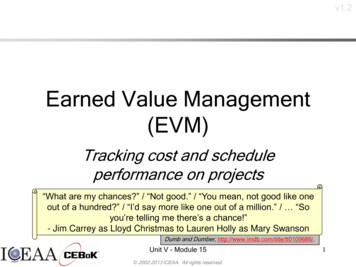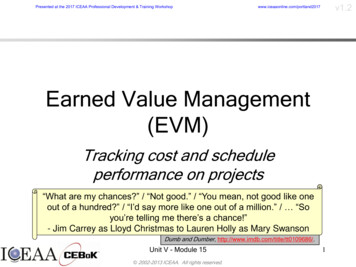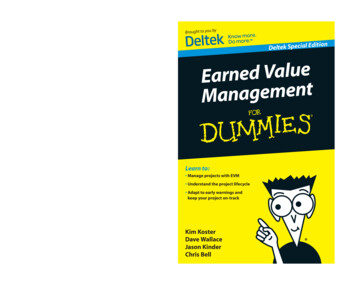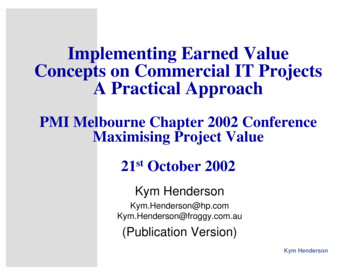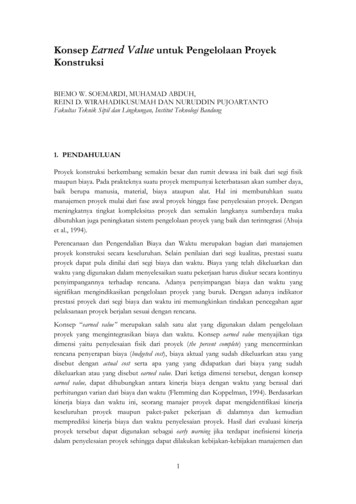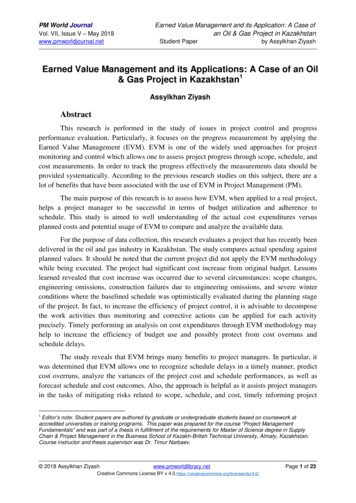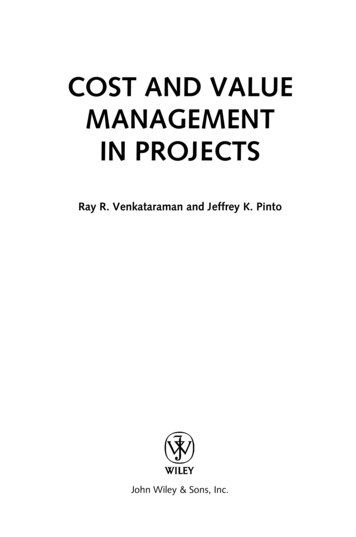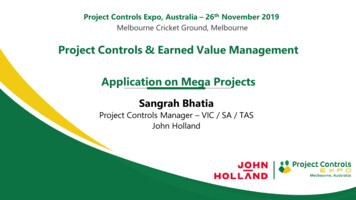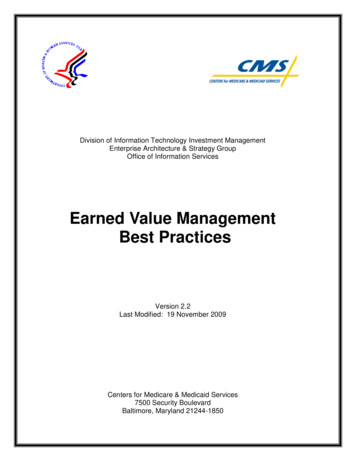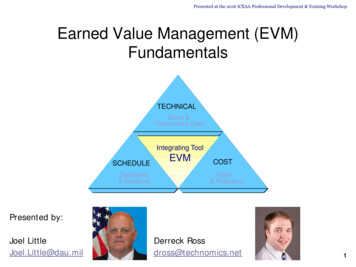
Transcription
Presented at the 2016 ICEAA Professional Development & Training WorkshopEarned Value Management (EVM)FundamentalsTECHNICALScope &Performance GoalsIntegrating ToolSCHEDULEConstraints& MilestonesEVMCOSTGoals& ProjectionsPresented by:Joel LittleJoel.Little@dau.milDerreck Rossdross@technomics.net1
The EVM Process- Integrated Program Management -Presented at the 2016 ICEAA Professional Development & Training WorkshopInternal & External ChangesPlanningExecutingControlling An Integrated Plan Is Established (PMB) Work Is Defined, Scheduled, andResources Are Allocated to LowestLevel for Execution Risks Are Identified (the IBR Process) Risk Management Plan Established Budgets Are “Earned” As Work Is Completed(Earned Value) Actuals Are Accumulated (ACWP) Status Provided Against Baseline (PMB) Variances Are Isolated (Cost/Schedule Drivers) Early Warning Management Actions Corrective Action Identified & Implemented Changes Are Implemented & Controlled Final Estimated Cost & Schedule are Forecast2
Presented at the 2016 ICEAA Professional Development & Training WorkshopDoDI 5000.02 EVM Policy GuidanceDoDI 5000.02, January 7, 2015Contracts* 100M Compliance with 32 EVMS GuidelinesFormal EVM system validationIPMR (All Formats Required)Integrated Baseline ReviewsOngoing SurveillanceContracts* 20M but 100M SEP 2015 Interim Class DeviationMemo raised thresholdSEP 2015 Interim Class DeviationMemo raised thresholdCompliance with 32 EVMS GuidelinesNo routine surveillanceNo Formal EVM system validationIPMR (tailored): Formats 1, 5, 6 & 7 requiredIntegrated Baseline ReviewsContracts* 20M EVM optional (PM’s risk-based decision) Cost-benefit analysis required IPMR tailored (Formats 1 and 5 recommended) Format 6 may be recommended* Contracts – Cost/Incentive, subcontracts, inter-government work agreementsEVM on FFP requires MDA approval; EVMIG also discourages nature of work (LOE or T & M)3
Presented at the 2016 ICEAA Professional Development & Training WorkshopDoDI 5000.02 EVM Policy GuidanceWith DPAP Interim Deviation ImpactContract TypeContract Value(Then-Year )Compliant with EIA - 748Compliant with EIA - 748Formal EVMS validation not requiredFormal EVMS validation requiredDCMA surveillance only conducted for causeRoutine DCMA surveillance performedNo MandatoryRequirementsEVM System RequirementEVM Data RequirementsCost Reimbursement & Incentive Contracts(EVM on FFP*, LOE, T&M and contracts 12 months duration is discouragedRisk Based DecisionIPMR Formats 1, 5 &7 Recommended 0 20MIPMR Tailored(Formats 1, 5, 6 & 7mandatory)IPMRAll 7 Formats required 50M 100M* Format 6 may be required on FFP4
Presented at the 2016 ICEAA Professional Development & Training WorkshopSection I - General Provisions FAR Clauses – July 2006 FAR 52.234-2 – Notice of EVMS – Pre-Award IBR FAR 52-234-3 – Notice of EVMS – Post Award IBR FAR 52-234-4 – EVMS – The Gov will conduct an IBR if a pre-award IBR hasnot been conducted. DFARS Section 234.203 – Solicitation provisions & contract clause (Dec2011) Use the provision at DFARS 252.234-7001, Notice of Earned ValueManagement System, instead of the provisions at FAR 52.234-2 and FAR52.234-3 in the solicitation Use the clause at DFARS 252.234-7002, Earned Value Management System,instead of the clause at FAR 52.234-4 in the solicitation and contract. Use DFARS 252.242-7005, Contractor Business Systems, to allow forwithholding payments due to non-compliant EVMS issue Includes links to procedures on performing cost benefit analyses and waiversDoD Contracts will NOT use FAR Clauses for EVM5
Presented at the 2016 ICEAA Professional Development & Training WorkshopSection J - Exhibits/Attachments Work Breakdown Structure - MIL-STD-881 mandatory common WBS for CPR,IMS, IPMR & CCDRs through WBS Level 3EVM Related Data Item Descriptions (DIDs)Contract Performance ReportIntegrated Master ScheduleDI-MGMT-81466ADI-MGMT-81650Integrated Program Management ReportDI-MGMT-81861(Supersedes CPR & IMS DIDs effective July 1, 2012) FM & Cost Related Data Item Descriptions (DIDs)Contract Work Breakdown StructureContract Funds Status ReportCost and Software Data Reports DI-MGMT-81334DDI-MGMT-81468ADI-FNCL-81565C thru 81567CContract Data Requirements List (CDRL) places CPR & IMS on contractEVM CDRLs can and should be tailored within bounds of policyTailoring options are limited for contracts 50MMost aspects are tailorable for contracts 50MConsider all risk factors when tailoring EVM DIDsType of contract (determined by cost risk)TechnologySchedulePast contractor performance6
Presented at the 2016 ICEAA Professional Development & Training WorkshopEVM Key ElementsQUESTIONANSWERACRONYMHow Much Work ShouldBe Done?Budgeted Cost ForWork ScheduledThe PlanBCWS/PVHow Much Work Is Done?Budgeted Cost ForWork Performed OrEarned ValueBCWP/EVHow Much Did TheCompleted Work Cost?Actual Cost OfWork PerformedACWP/ACWhat Was The Total JobSupposed To Cost?Budget At CompletionBACWhat Do We Now Expect TheTotal Job To Cost?Estimate At CompletionEAC7
Presented at the 2016 ICEAA Professional Development & Training WorkshopWhere does it all start?8
Presented at the 2016 ICEAA Professional Development & Training WorkshopEarned Value Management withinthe Contracting ProcessGOVERNMENTNEGOTIATIONSOURCE SELECTIONAWARD ROVIDERDEVELOPPROPOSALESTABLISHPROJECTBASELINEMGT VOLUMEASSESS RISKTECH VOLUMEDEVELOP MRCOST VOLUMEASSIGN BUDGETSPROJECTEXECUTION &PERFORMANCEMEASUREMENT9
Presented at the 2016 ICEAA Professional Development & Training WorkshopPMB Development StepsStep 1. Define the Work ScopeStep 2. Schedule the WorkStep 3. Allocate Budgetsto Schedule1004050 Identify the scope of work Plan the work at the control account /work package level Arrange the work packages in order Schedule work packages Classify the work and select an EVtechnique Budget the work packages Spread the budget over time Calculate cumulative BCWS10
Presented at the 2016 ICEAA Professional Development & Training WorkshopThe Control Account All earned value is accomplished at the control account BCWS/PV is established BCWP/EV is determined ACWP/AC is collected Variances are assessed Estimates are revised Workaround plans are devisedIn IPT organization structures, the control account may be tied toan IMP Significant Accomplishment or Accomplishment Criteria.EIA 748 Definition - A management control point at which budgets(resource plans) and actual costs are accumulated and compared toearned value for management purposes. A control account is anatural management point for planning and control since itrepresents the work assigned to one responsible organizationalelement on one program work breakdown structure element.11
Presented at the 2016 ICEAA Professional Development & Training WorkshopSchedule IntegrationHorizontal IntegrationMASTER SCHEDULE-Single Top Program Level ScheduleSchedules IMP Program ElementsSchedules Program and Contract MilestonesHorizontally Integrated – Depicts task relationshipsamong IMP Program Elements and Milestones20101 TimeINTERMEDIATE LEVEL SCHEDULE- Subordinate to Master Schedule scheduling a single ora limited number of Program Elements- Schedules Associated EVMS Control Accounts- Schedules IMP Significant Accomplishment Milestones- Horizontally Integrated – Depicts task relationshipsamong control accounts & significant accomplishments- Vertically Integrated – All schedule elements completedin time allocated to associated program level element24Vertical IntegrationITEM11121314151617CONTROL ACCT 14CONTROL ACCT 15CONTROL ACCT 16CONTROL ACCT 17CONTROL ACCT 18CONTROL ACCT 19Horizontal IntegrationVertical IntegrationDETAIL LEVEL SCHEDULE- Control Account Schedule- Schedules IMP Accomplishment Criteria Milestones- Horizontally Integrated – Depicts task relationshipsamong Work Packages & Accomplishment Criteria- Vertically Integrated – All detailed schedule workpackages completed in time allocated to control account1213Control Acct 16Horizontal Integration12
Presented at the 2016 ICEAA Professional Development & Training WorkshopEarned Value TechniquesMethodLength0 / 100 %1 Mth50 / 50 %2-3 Mths% CompleteVariesVariant Milestone3 or more MthsLevel of EffortVariesApportioned EffortVariesBCWP Example13
Presented at the 2016 ICEAA Professional Development & Training WorkshopResult: Time Phased PMBTotal Allocated BudgetManagement ReserveBAC TimeCompletionDate14
Presented at the 2016 ICEAA Professional Development & Training WorkshopIntegrated Program ManagementReport (IPMR) Format 1 –Format 2 –Format 3 –Format 4 –Format 5 –Format 6 –Format 7 –Work Breakdown Structure (WBS)Organizational Breakdown Structure (OBS)Baseline DataManpower DataVariance AnalysesIntegrated Master ScheduleHistorical Data (BCWS, BCWP, ACWP, BAC, EAC, etc.)EVM provides an Objective means by which to Evaluate ContractPerformance and predict the Future based on risk15
Presented at the 2016 ICEAA Professional Development & Training WorkshopGeneral EVM Report Tailoring IPMR Tailoring Guidance Format 1 & 2 Reporting LevelsReporting FrequencySubmission DatesDate of first and last reportsFormat 5 variance reportingthresholds Fixed Number of Variances Percentage or Dollar Thresholds Specific Variances IMS Tailoring Guidance Degree of networkingReporting FrequencySubmission DatesDate of first and last reportsFrequency of schedule riskanalysis Electronic data interchangeformat Contractor format Electronic data interchange format16
Presented at the 2016 ICEAA Professional Development & Training WorkshopExample -- With Earned Value Contract: 4 Miles of Railroad Track in 4 Mos for 4KStatus:After 3 Mos Only 1 Mile of Track isComplete yet 2K SpentQuestion: What Would You Tell the PM?BCWSSchedule Variance 1K- 3K ( 2K)66% BehindPlanned Work 3KBCWPEarned Value 1KCost Variance 1K- 2K ( 1K)100% OverrunACWPActual Costs 2KLabor 1KMaterial 1K17
Presented at the 2016 ICEAA Professional Development & Training WorkshopExample -- Without Earned Value Contract: 4 Miles of Railroad Track in 4 Mos for 4KStatus:After 3 Mos Only 2K Spent of 3K PlannedQuestion: How are You Doing and How Do You Know?Planned Work 3KActual Costs 2KLabor 1KMonth 1 @ 1KMaterial 1KMonth 1 @ 1KMonth 1 @ 1K18
Presented at the 2016 ICEAA Professional Development & Training WorkshopProgram at a GlanceEACOverBudgetTotal Allocated BudgetBACManagement ReservePROJECTEDPMBSchedule Variance Cost NowSLIPPAGECompletionDate19
Presented at the 2016 ICEAA Professional Development & Training WorkshopSample IPMR – Format 1Boxes 1 - 4Key Contract &Contractor DataNew OTB/OTS BoxBox 5Box 7Box 6Budget and EAC DataPop I SmithBox 8BCWS BCWP ACWPSVCVBCWScumBCWPcum ACWPcumSVCVBACEACVACFormat 1 provides summary level data to measure cost and scheduleperformance using a Work Breakdown Structure (WBS) layout. Format1 is required for all contracts requiring EVM. All CPR data is at cost(except Format 1 Box 5 Price Data)20
Presented at the 2016 ICEAA Professional Development & Training WorkshopSample IPMR – Format 2Key Contract &Contractor DataBoxes 1 - 4Box 5BCWS BCWP ACWPSVCVBCWScum BCWPcum ACWPcumSVCVBACEACVACFormat 2 provides data to measure cost and schedule performancedata by the contractor's organization or IPT structure. It includesEVM data for material accounts and major subcontracts. Format 2 isoption for contracts 50M. All Format 2 CPR data is at cost data(no fee or profit added).21
Presented at the 2016 ICEAA Professional Development & Training WorkshopSample IPMR – Format 3Boxes 1 - 4Box 5Key Contract &Contractor DataBudget and Key DatesBox 6The EV performance measurement baseline at beginning of the periodFormat 3 provides the budget baseline plan against which performance is measured. Format 3 isoption for contracts 50M. Unlike format 1 and 2 which each report historical performance, Format 3forecasts the plan for the next six months and other selected intervals.The updated EV performance measurement baseline at end of periodreflecting accomplishments and replanned activities—THE NEW PMBBCWSManagement Reserve Box 7TotalBox 822
Presented at the 2016 ICEAA Professional Development & Training WorkshopSample IPMR – Format 4Boxes 1 - 4Key Contract &Contractor DataBox 5Format 2OrganizationalReportingStructureFormat 3 Forecast PeriodsFormat 4 provides staffing forecasts for correlation with the budget plans, costand schedule estimates. It includes EVM data for material accounts and majorsubcontracts. Format 4 is option for contracts 50M. Format 4 is reported bystaff months rather than dollars or hours.Box 623
Presented at the 2016 ICEAA Professional Development & Training WorkshopSample IPMR – Format 5Boxes 1 - 4Box 5Key Contract &Contractor DataDiscussion should include but is not limited to: Summary Analysis Summary of Overall Contract Variances Changes in Management Reserve Changes in Undistributed Budget Differences between EAC's (Blocks 6.a, 6.b, 6.c, or Block 8.15) (Format 1) Significant timephasing shifts in Baseline (BCWS) (Format 3) Significant timephasing shifts or Overall Changes in Forecasted Staffing (Format 4) Discussion of Over Target Baseline and/or Over Target Schedule incorporationAnalysis of Significant Variances: (identify and describe each) Type and Magnitude of Variance Explanation of Significant Reasons Effect on Immediate Task Effect on Total Contract Corrective Actions Taken or PlannedFormat 5 is a narrative report used to explain significant cost and schedule variances and other identifiedcontract problems and topics. It is mandatory for all EVMS contracts. Research has indicated that two thirds ofthe costs associated with EVMS can de attributed to variance analysis reporting.24
Presented at the 2016 ICEAA Professional Development & Training WorkshopSample IPMR – Format 625
Presented at the 2016 ICEAA Professional Development & Training WorkshopSample IPMR – Format 7IPMRWBSElementBCWSBCWPACWPEAC1 / Jan20151.1.1155641345814221257891 / Jan20151.1.212781114137826781 / Jan20151.1.32241182006451 / Jan20151.2.117891178451624769587 TRN or XML/UNCFACT Format containing:Historical data (BCWS, BCWP, ACWP, BAC, etc )Future data (ETC, EAC, etc )26
Presented at the 2016 ICEAA Professional Development & Training WorkshopPerformance DataAnalysis Objectives Determine Current Status (Top Drivers) Where Are We Today?Identify Trends Where Are We Headed? Any Cost, Schedule Surprises?Forecast The Future (EAC Realism) What Is The EAC (Cost & Price)? What Is The Impact On The Budget?Indicate Areas For Management Action What Should We Do Now?Challenge – Turning Data Into MeaningfulInformation for Decision Makers27
Presented at the 2016 ICEAA Professional Development & Training WorkshopPast Performance – Root Causes CV / CPI 1.0-CV / CPI 1.0 SV / SPI 1.0-SV / SPI 1.0Work is costing less thanplanned:Work is costing more thanplanned:Work is beingaccomplished faster thanplanned:Work is being accomplishedslower than planned:– More efficient & usingfewer hours/mat’l– Using less expensivelabor category/mat’l– Achieved a technicalbreakthroughDelay in payment. Workcomplete but actualshave not hit ledger yetIncorrect status. Tookcredit for work notactually completedImproper charging. Tookcredit for work yet actualswere charged against thewrong account– Less efficient & usingmore hours/mat’l– Using a more expensivelabor category/mat’l– Additional travel(ODCs)/Rework incurred– Rates (OH, G&A,inflation) increased– Encountered TechnicalproblemsIncorrect status. Did nottake credit for workactually completedImproper charging.Actuals were incorrectlycharged against theaccountRequirements Change.In scope contractrequirement changed– More efficient & takingless time– Achieved a technicalbreakthroughWork has beenaccelerated in theschedule. Due toprogrammatic events,work has shifted forwardIncorrect status. Tookcredit for work notactually completedBaseline Mistake.Incorrectly set work tooccur later than it wassupposed to– Less efficient & taking moretime.– Encountered TechnicalproblemsWork has slipped in theschedule:– Due to programmatic events(late GFE, GFI,predecessor priorities, etc.),work has shifted right– Due to lack of resources,work has shifted rightIncorrect status. Did not takecredit for work actuallycompletedBaseline Mistake.Incorrectly set work to occurbefore it was supposed toRequirements Change. Inscope contract requirementchanged28
Presented at the 2016 ICEAA Professional Development & Training WorkshopPast Performance – AnomaliesAnomalyConcernBCWS BCWP ACWP(and 0)Not really using Earned Value – “Perfect data”BCWP 0, ACWP 0“Free” performanceBCWP 0 and BCWS 0BCWP is dependent on BCWS, so why is thereperformance without planned performanceACWP 0 and BCWP 0What is being paid for without getting any performance?BCWP or BCWS BAC 100% complete? 100% planned?BAC 0 and EAC 0Work is planned (BAC/BCWS), but costs are expectedto come in at 0 (EAC/ACWP)?EAC 0 and BAC 0Cost (EAC/ACWP) are expected for element that hasno planned value (BAC/BCWS)?BCWS, BCWP, ACWPnegativeNegative (“giving back”) plan, performance, actualsBAC 0 and/or EAC 0Negative (contractor giving to Government) total plan(BAC) and/or total expected plan at complete (EAC)29
Presented at the 2016 ICEAA Professional Development & Training WorkshopEstimate at Completion (EAC)- What Will Be The Final Cost? Objective, mathematical Estimates At Complete (EACs)can be calculated Most common are CPI and CPI * SPI CPI Forecast (Mathematical Extension) ACWP BCWR / CPI BAC / CPI Assumes even cost performance across the entire project equal toperformance experienced to date Referred to as “best case” EAC CPI * SPI Forecast (Composite) ACWP BCWR / (CPI*SPI) Also assumes that past cost and schedule performance are indicative offuture performance Adjusts estimate to account for schedule performance experienced todate Referred to as “worst case” EAC Other EAC Methods: CPI/SPI mixes: 50/50 (CPI/SPI), 80/20 (CPI/SPI), 90/10 (CPI/SPI), Recent Performance: 3 Month CPI, 6 Month CPI, 9 Month CPI, Historical Methods: Historical (Similar CPI @ Completion to finishedproducts), % Complete (Similar CPI change to finished products)30
Presented at the 2016 ICEAA Professional Development & Training WorkshopEAC Realism Common Performance Factor Methods TCPI To Complete Performance Index Efficiency Necessary To Complete –Either On Budget (BAC) Or On The (EAC).TCPI (BAC) Work RemainingCost Remaining BAC – BCWPBAC - ACWP TCPI (BAC) Work Remaining / Cost Remaining TCPI (BAC) ( 4k - 1K) Compare CPI & TCPI to Assess Realism Of Future Performance – “RealityCheck”/ ( 4k - 2K) 3K / 2K 150% TCPI 150% while CPI 50% They are earning 0.50 on the dollar spent, and their performance will have toimprove to earning 1.50 per dollar spent for the remainder of the contract.If TCPI CPI by .05, Then Question EACIf TCPI or CPI by .10 Then OSD TW tripped31
Presented at the 2016 ICEAA Professional Development & Training WorkshopSummary Earned Value Management is required by Law, OMB Circular A-11policy guidance, and DoDI 5000.2EVM is the most comprehensive program management toolSenior DOD and Congressional Leaders use it to make programdecisionsManagement involvement ensures EVM data is used in a proactivemanner to manage programs and make timely corrective actiondecisionsEVM helps you identify risk, ask the right questions and make sounddecisions to Keep Programs on Track.32
Presented at the 2016 ICEAA Professional Development & Training WorkshopQuestions?33
FAR 52-234-3 - Notice of EVMS - Post Award IBR FAR 52-234-4 - EVMS - The Gov will conduct an IBR if a pre-award IBR has not been conducted. DFARS Section 234.203 - Solicitation provisions & contract clause (Dec 2011) Use the provision at DFARS 252.234-7001, Notice of Earned Value Management System, instead of the provisions at FAR 52.234-2 and FAR 52.234-3 in the .
